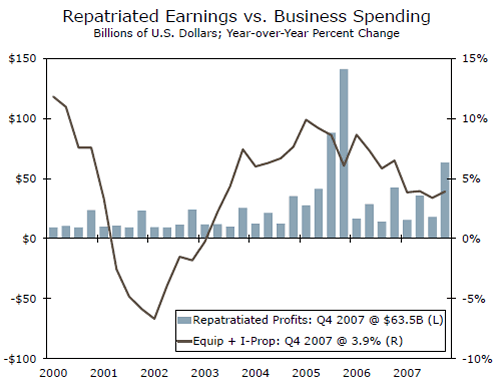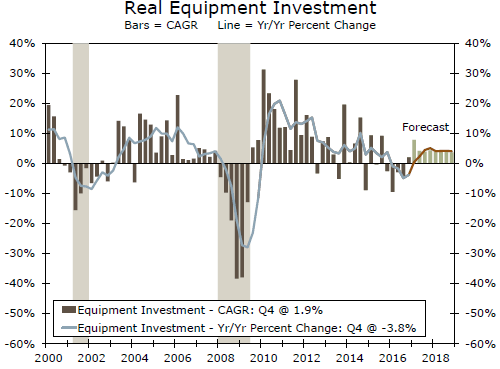U.S. Review
A Slow Start to the Year
- Consumer spending was soft again in February, rising just 0.1 percent for the month while personal income growth remained robust, rising 0.4 percent.
- Consumer confidence data for the month of March continued to indicate that consumers are feeling more optimistic with the current and future economic environment.
- Real GDP growth for Q4 was revised up slightly to 2.1 percent from 1.9 percent.
- Inflation, as measured by the PCE Deflator, edged up to 2.1 percent on a year-over-year basis in February.
A Slow Start to The Year
Economic data this week continued to indicate that first-quarter GDP growth will be soft. Personal income rose a robust 0.4 percent, while personal spending rose a slight 0.1 percent in February. A continued rise in consumer confidence in March, however, may signal that consumer spending might begin to pick up in the months ahead. The third look at GDP growth for the fourth quarter showed that the economy expanded at a 2.1 percent pace to close out 2016. The slight upward revision was attributed to somewhat higher real consumer spending and slightly higher business investment. After taking into consideration data since we published our March monthly forecast, we have downwardly revised our call for Q1 GDP growth. We now expect a 0.5 percent pace of growth, relative to our March monthly forecast of 1.1 percent.
Personal income rose 0.4 percent in February, while January’s reading was revised slightly higher to 0.5 percent. After controlling for inflation, real after tax personal income fell 0.1 percent in February. Inflation, as measured by the PCE deflator, continued to edge higher for the month and which supports our call for two more hikes from the Federal Open Market Committee for the reminder of the this year. One of the more disappointing aspects of the personal income and spending report this week was the slight 0.1 percent increase in personal spending. After accounting for inflation, real consumer spending for February fell 0.1 percent after declining 0.2 percent in January. While we await the official Q1 GDP release to single out the reasons for the softness, a downshift in utilities output from the industrial production report for the first two months of the year suggests that consumer spending for services is likely to be light in Q1. In addition, a law change affecting tax fillers who claim the Earned Income Tax Credit and Additional Child Tax Credit delayed tax refunds until Feb. 15th for millions of Americans, which served to slow the pace of consumer spending in January and for most of February.
While consumer spending is off to a slow start this year, measures of consumer confidence continued to signal optimism. Consumer assessment of both current and future economic conditions remains high. The Conference Board’s measure of confidence climbed to the highest level since December 2000. More important for real consumer spending, consumer’s outlook for income growth and job growth both posted rather dramatic improvements over the past two months. In our view, this should translate into stronger real consumer spending growth beyond the first quarter.
While current quarter consumer spending will likely be soft, housing market data has begun to surprise to the upside. Pending home sales climbed 5.5 percent in February after falling 2.8 percent in January. In addition, new home construction bounced back in February more than offsetting January’s decline. We now think that real residential investment will expand at a 10.5 percent pace in Q1, making residential investment in Q1 one of the few bright spots in our outlook for Q1 GDP growth.
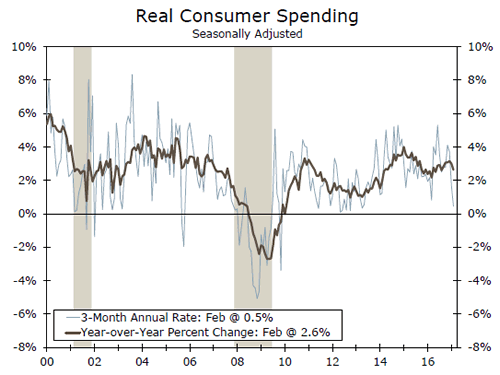
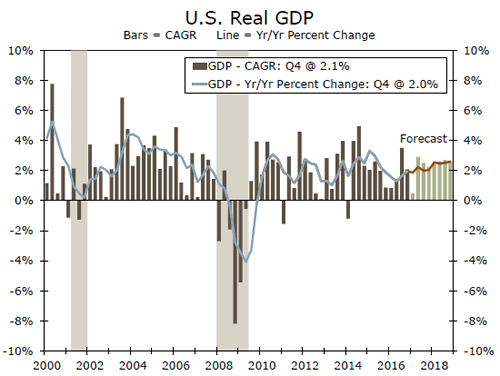
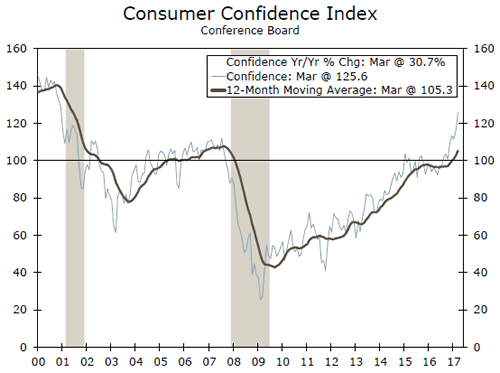
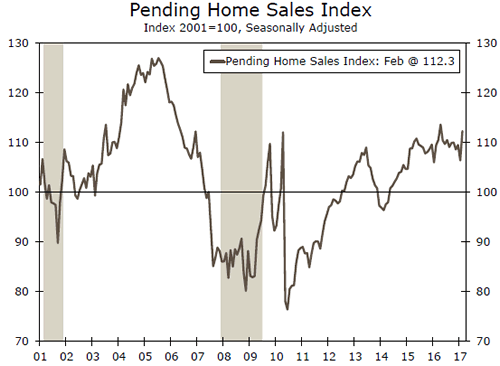
U.S. Outlook
ISM Manufacturing • Monday
The ISM manufacturing composite continued to climb in February, jumping 1.7 points to 57.7 as manufacturers move on from the challenging period from 2015-2016. Most subcomponents rose in February, with strong jumps in new orders and production. The employment index slipped slightly but held in expansionary territory, which was verified by February’s jobs report that showed a solid jump in manufacturing employment.
Hard data on factory orders and production have yet to match as survey measures, but final factory orders for February are also released next week, which may more closely follow the ISM. Moreover, there is underlying firming in the U.S. factory sector as commodity prices stabilize and global economic activity increases. We continue to keep our expectations in check for the factory sector, with solid steady gains in U.S. manufacturing.
Previous: 57.7 Wells Fargo: 57.1 Consensus: 57.1
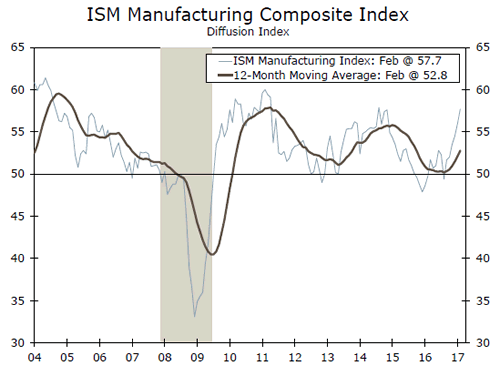
Trade Balance • Tuesday
The U.S. trade deficit widened in January, to -$48.5 billion, as imports rose faster than exports. Imports of goods and services from other nations jumped $5.3 billion, while U.S. exports rose $1.1 billion. Some of January’s import rise was in petroleum, but gains were also broad based among other categories, reflecting strong domestic demand. Real imports also rose more than real exports in the first month of 2017, which was an unfortunate start for Q1 GDP growth.
Preliminary data on goods trade released this week suggest that the goods-trade deficit narrowed in February. Advanced data show most of the drop was on the import side of the ledger, particularly of automotive and consumer goods. Automotive exports also slipped the preliminary February data, but by a lesser amount. We expect the final trade balance of goods and services to narrow in February to a deficit of -$44.5 billion.
Previous: -$48.5B Wells Fargo:-$44.5B Consensus: -$45.0B
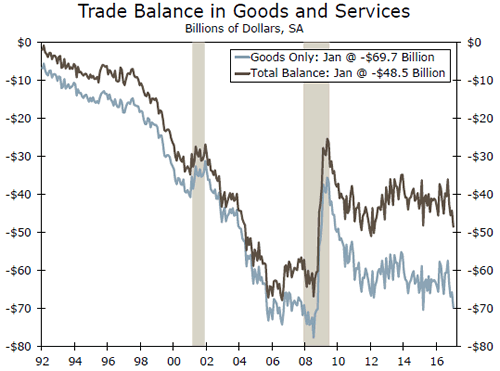
Employment Report • Friday
The U.S. labor market remained robust in February, surprising markets by adding 235,000 jobs, bringing the three-month average gain to 209,000 jobs. Manufacturing and construction had strong months of hiring, as the factory sector rebuilds its workforce and mild winter weather pulled construction work forward in February. We may see some payback in construction job gains in March, but ISM employment indices continue to point to expanding manufacturing payrolls, though the pace may moderate. We expect the U.S. economy added 191,000 jobs in March, which is closer to its average over the past year and well above consensus.
The tight labor market may restrain hiring, with the unemployment rate currently at 4.7 percent in February. We expect the jobless rate was 4.7 percent in March.
Previous: 235K Wells Fargo:191K Consensus: 175K
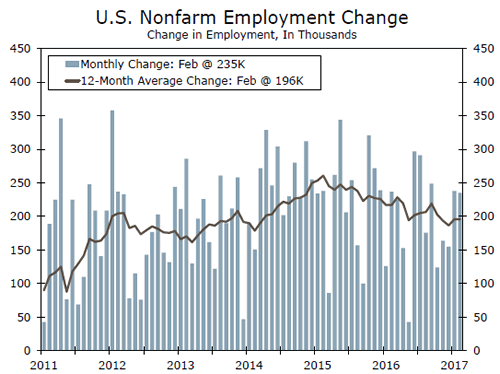
Global Review
Mexico’s Central Bank Raises Rates Again
- Economic activity in Mexico accelerated in January, up 2.96 percent year over year, besting market expectations of slower growth. Mexico’s central bank increased its overnight bank rate to 6.50 percent at its most recent meeting.
- Inflation in Japan rose for the second consecutive month and retail sales are seeing meager gains as stagnant wage growth and higher energy prices weigh on personal consumption.
- As largely expected, Prime Minister May pulled the trigger on Article 50, starting the two-year legal process between the U.K. and the EU to sever its 44-year relationship.
Mexico’s Central Bank Raises Rates Again
In Mexico, January’s year-over-year change in economic activity index, which is highly correlated with overall GDP growth, bested market expectations by growing at a faster-than-expect 2.96 percent, up from 2.08 percent in December. Much of the gain was from a 12.8 percent jump in the agriculture sector and a 4.1 percent gain in the services sector, year over year. Both sectors have been showing improvement in recent months. On the other hand, Mexico’s industrial sector is still showing some weakness on a year-ago basis, down 0.1 percent year over year, but this is likely due to the drag from utilities.
At its latest meeting, Mexico’s central bank raised interest rates for the fifth time in a row, up 25 bps to 6.50 percent—pushing the overnight rate to a level not seen since early 2009. That said, we do not expect the central bank to keep raising rates at such an aggressive pace over the longer term. The recent peso rally has alleviated some of the inflationary pressures. Inflation increased to 4.9 percent year over year in February. Mexico’s central bank, however, expects inflation to come back toward its 3 percent target by next year.
Japan’s Inflation Rises, but Consumer Spending Shrinks
Meanwhile in Japan, consumer prices rose 0.3 percent in February, besting market expectations of a 0.2 percent increase. Japan’s core inflation, which excludes fresh food prices, rose 0.2 percent. The increase in core inflation is good news for the Bank of Japan, which chose to keeps rates unchanged at its last meeting. However, higher energy prices have pushed up prices instead of solid economic growth. Excluding both food and energy prices, inflation is 0.1 percent lower than it was last year.
Retail sales rose 0.1 percent year over year in February, marking four sequential gains—welcomed news after eight months of declines. Despite the gains, sales in supermarket and department stores are down 2.7 percent from last year. Some of the weakness can be explained by fewer "selling" days this year as last year was a leap year, but stagnant wage growth, paired with higher price inflation is starting to erode consumer spending. This can be seen in the downshift in overall household spending in Japan, down 3.8 percent on a year-ago basis.
U.K. Signed the Divorce Papers
In a historic, yet highly anticipated moment, Prime Minister May triggered Article 50 of the Lisbon Treaty, formally declaring the U.K.’s intentions to withdraw from the EU. The signing begins the two-year legal process that will end with the U.K. leaving the EU. The Great Repeal Bill: White Paper, released by the U.K. government, laid out the country’s proposals and converted some of the existing EU laws into domestic law. It is also worth noting that the U.K. is still a part of the EU and will continue to uphold the EU laws until exit, unless an extension is granted by the European Council. That said, we still look for the U.K. economy to remain stable, growing at 1.8 percent year over year in 2017 and in 2018. We also expect for the Bank of England to be cautious in the near term and leave rates unchanged for the rest of the year.
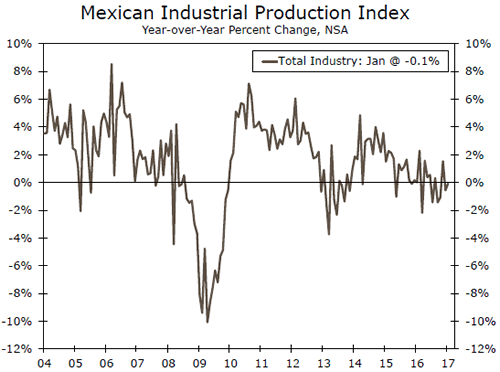
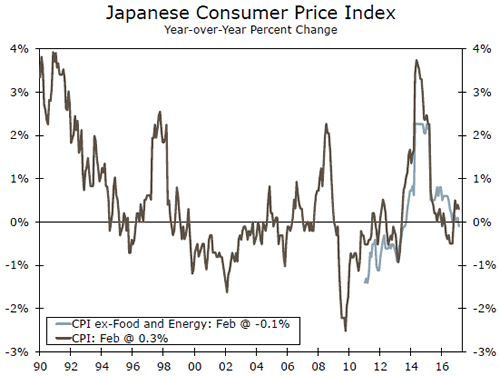
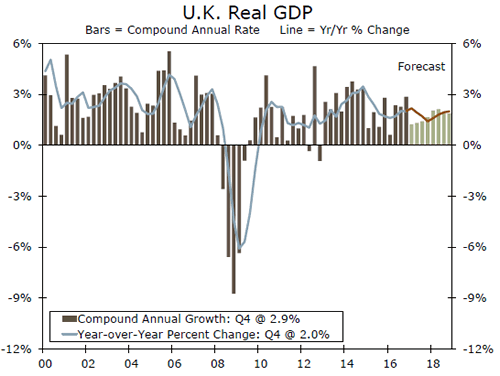
Global Outlook
Brazil Industrial Production • Tuesday
The Brazilian industrial production index emerged from negative territory in January on a year-over-year basis for the first time since February 2014. The turnaround in industrial activity is certainly a boon for the Brazilian economy, which has been in a recession since the beginning of 2015. GDP growth is expected to turn positive in Q1 of this year.
The mining sector, which has weighed heavily on industrial growth, grew 4 percent in Q4 2016. Manufacturing and utility production, however, contracted 2.4 percent and 7.5 percent in Q4 2017, which may restrict industrial activity from recovering fully in the near term. Industrial production is expected to have grown 0.4 percent in February. Also slated for release this week is Brazil’s Manufacturing PMI, which has been in contractionary territory since February 2015.
Previous: 1.4% (Year-over-Year) Consensus: 0.1%
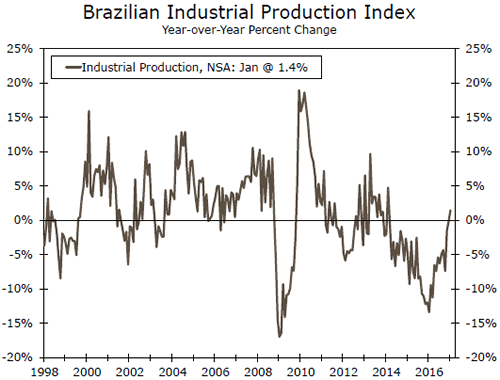
China Caixin Composite PMI • Wednesday
The Caixin composite PMI, which measures Chinese manufacturing and service firms linked to the rest of the global economy, increased to 52.6 in February from 52.2 in January. The index has been in expansionary territory since February 2016. Because China is the second-largest economy and the world’s largest metals consumer and producer, this index is watched very closely.
China’s Caixin manufacturing PMI will be released later in the day, with analysts expecting a 51.7 figure. The manufacturing PMI has been above the 50-threshold for eight consecutive months. Moreover, China’s Caixin service PMI dropped to 52.6 in February from a 53.1 reading in January. Despite the month-over-month slowdown in the service component, the index remains comfortably in expansionary territory.
Previous: Manufacturing: 51.7; Services: 52.6 Consensus: Manufacturing: 51.7; Services: 51.7
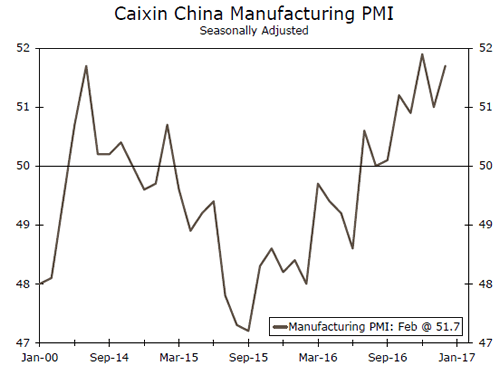
U.K. Industrial Production • Friday
Industrial production (IP) in the United Kingdom decreased 0.4 percent in January compared to activity in December, but has grown 3.2 percent year over year. During January, mining activity grew 1.4 percent while manufacturing utilities expanded 1.5 percent. Dragging down the index was manufacturing activity, which contracted 0.9 percent. Despite the monthly slowdown, manufacturing has grown 2.7 percent year over year, perhaps supported by strong exports against the backdrop of a weak domestic currency. Markets expect IP activity to have increased 3.7 percent year over year in February.
Manufacturing production, also slated for release on Friday, is expected to have increased 0.2 percent on the month and to have grown 3.8 percent from a year ago.
Previous: 3.2% (Year-over-Year) Consensus: 3.7%
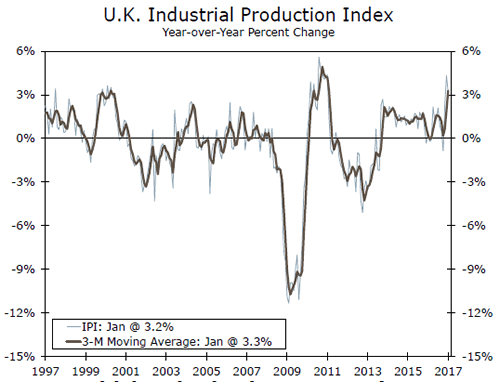
Point of View
Interest Rate Watch
Reaching the Fed’s Inflation Target
While it was another week and another strong showing for "soft" data on the economy, the strength exhibited in the latest consumer confidence reading, including the improved views toward future income, has not translated into higher inflation expectations. Consumer inflation expectations, measured by the Conference Board and the University of Michigan Consumer Sentiment survey, fell in March and remain near at least six-year lows. The lack of reflation in consumers’ inflation expectations remains consistent with the FOMC’s go-slow approach to normalization outlined in the latest dot plot and echoed in comments this week.
Yet, inflation is rising. The Fed’s preferred gauge, the PCE deflator, reached the FOMC’s 2 percent target this week for the first time since 2012. The return to the Fed’s target can be largely traced to the rebound in energy prices, but core inflation at 1.8 percent is also rising.
An alternative measure of core inflation, suggests that the underlying trend is even closer to the FOMC’s target. The Dallas Fed’s Trimmed Mean PCE deflator has again started to pull away from the traditional core index (middle graph). The trimmed mean PCE deflator is designed to track the trend in inflation better than the traditional core PCE, which simply excludes food and energy. The upward trend offers further evidence that inflation pressures are still rising, albeit gradually.
Most FOMC members, including Chair Yellen, remain firm believers in the link between wages and inflation. As indicated in the bottom chart, average hourly earnings have been trending higher over the past year and are expected to post a decent 0.3 percent monthly gain in March. While weak versus prior cycles (due in part to secular forces like weaker productivity and an aging workforce), the upward trajectory should be enough for the Fed to continue apace with tightening this year, even if consumers do not yet believe that stronger inflation is on the horizon.
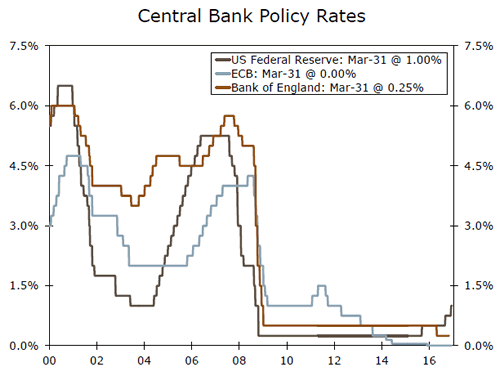
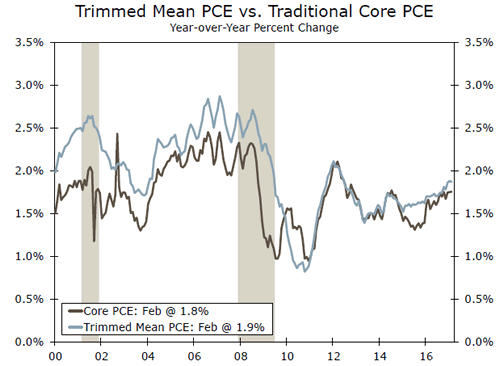
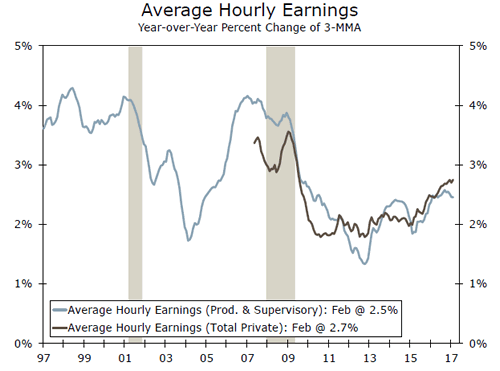
Credit Market Insights
Assessing the Assets
Household asset appreciation remained firm to end 2016, increasing 2.1 percent for the second consecutive quarter. Real per capita household net worth is at an all-time high of $257,989, well above the prerecession peak of $234,050 in Q1 2007.
Household asset holdings in this cycle are more heavily tilted toward financial assets than tangible assets, such as real estate. This trend is more reminiscent of the late 1990’s tech boom than the housing boom in the 2000s. Furthermore, asset appreciation has continued to start the year. The S&P 500 is up about 5 percent thus far in 2017, and home price appreciation has remained steady amid lean inventories. Thus, it seems likely that household net worth will continue to trek higher in Q1.
Fed officials have at times made note of rising asset prices and have raised concerns about highly accommodative monetary policy driving asset valuations. Prior to the Fed speak that significantly raised the probability of a March rate hike, there were questions about whether the "hard" economic data had improved enough to warrant back-to-back rate hikes. Perhaps the recent strength in asset prices played a role in the Fed’s decision. Household assets relative to the size of the economy are historically high, with the peak of the housing bubble the only recent comparable period. If this trend continues and the Fed is indeed weighing asset valuations in its interest rate decision-making, further tightening would likely be on the horizon.
Topic of the Week
Taxing Questions: Corporate Tax Reform & Capex
Policymakers from both major political parties in the United States in recent years have advocated for a repatriation tax holiday, which would offer U.S. corporations the opportunity to bring those profits back to the United States at a rate substantially lower than the current corporate statutory tax rate of 35 percent. Among the oft-cited justifications for a tax holiday is that businesses suddenly flush with cash would boost corporate capital spending and hiring plans.
The prior repatriation tax holiday, the Homeland Investment Act of 2004, and the inflows that followed in 2005 showed that repatriations did not lead to an increase in domestic investment and job growth; if anything, outlays slowed and jobs were lost. Indeed, businesses rushed to take advantage of the temporary tax break, but, due to loopholes, funds were used to pay dividends or buy back stock from shareholders. The corporate sector was in good financial health then, and companies were not holding back on capital spending due to financial constraints that would be alleviated with the tax holiday. That said, does the current business environment suggest this time may be different?
The short answer is no. The corporate sector does not appear to be financially constrained at present and is not in need of another repatriation holiday. Profits as a share of GDP are higher than when the 2004 repatriation holiday was passed. Layoffs are at a fourdecade low, and job growth remains strong. While we expect corporate tax reform to include a permanent reduction in the tax rate for profits from overseas, the current environment and past experience suggest it will have only a negligible impact on capital spending. Instead, we expect other drivers of business spending, including rising profits, greater business optimism and stronger final sales, to boost equipment and intellectual property spending in the current year and on into 2018.
